El Clásico never disappoints.
An early goal from İlkay Gündoğan and a strong first-half performance from Barcelona gave the hosts and their fans hope of securing three points against their eternal rivals. Fluid in possession and dangerous in the final third, Barcelona looked as if they would take points off of Real Madrid.
But El Clásico is not without its drama. Jude Bellingham levelled the score with a stunning finish from distance and then silenced the stadium with his stoppage-time winner.
In a match that featured an excellent start from Barcelona and a well-calculated response from Carlo Ancelotti and Real Madrid, this tactical analysis will look at how Barcelona were able to set the match initiative in the first half and how Real Madrid’s issues in the high press created problems higher up the pitch. This match was won in the second half, both from the half-time response and Ancelotti’s substitutions.
We’ll delve into how Real Madrid were able to wrestle control of the match from Barcelona and show the impact of the substitutions for each team.
Lineups
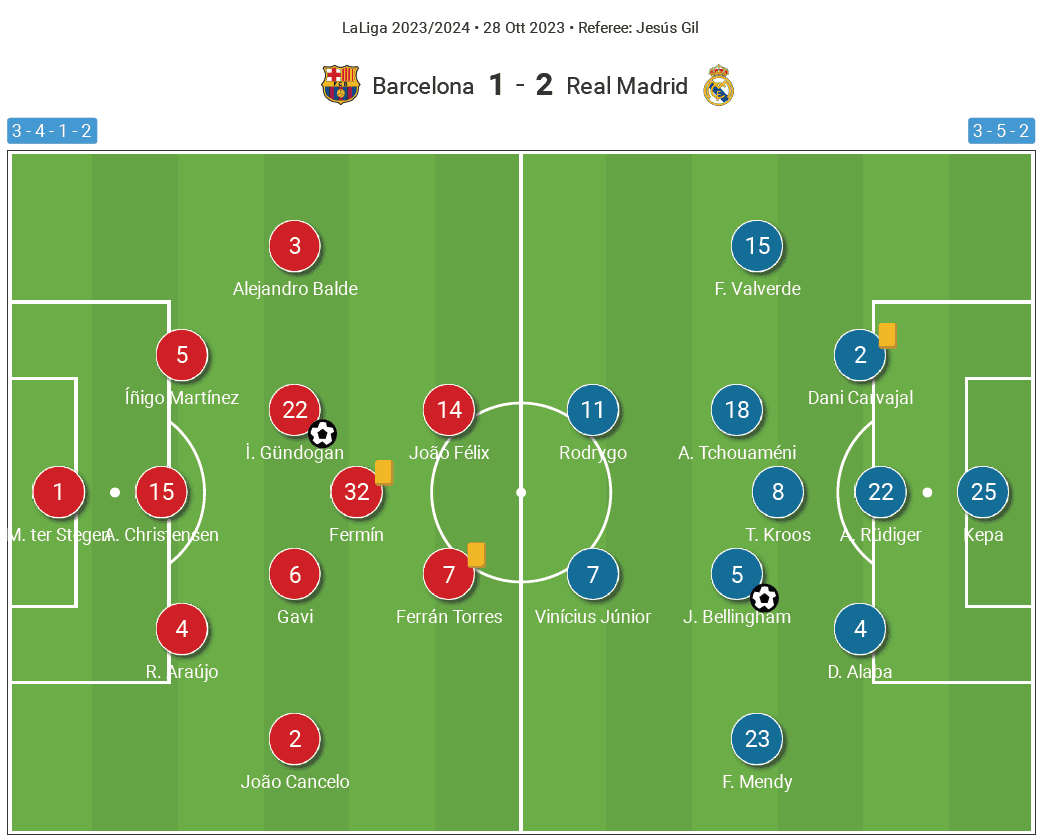
This was a match with very fluid formations throughout. At times, each side showed a back three; at others, a typical 4-3-3. Let’s not forget Ancelotti’s preferred 4-4-2 with the diamond midfield when his side is playing without a true #9. The systems were little more than numbers in this match as both sides seamlessly adapted to create new attacking opportunities and organise defensively. Since Wyscout lists a 3-5-2/3-4-1-2 for each team, we’ll use those setups as the base formations.
Xavi came into this match with players returning from injuries, most notably Robert Lewandowski and Raphinha, but he leaned on the more in-form players to start the match. Marc-André ter Stegen took his place in goal with a backline of Iñigo Martínez, Andreas Christensen and Ronald Araújo. Alejandro Balde and João Cancelo were the wingbacks, while the midfield consisted of İlkay Gündoğan and Gavi as the pivots and Fermín López in front of them. The two forwards were João Félix and Ferran Torres.
Ancelotti countered with a similar setup featuring Kepa Arrizabalaga in goal and a backline consisting of Dani Carvajal, Antonio Rüdiger and David Alaba, with Ferland Mendy and Federico Valverde as the wingbacks. In midfield, Toni Kroos and Aurélien Tchouaméni anchored the group, while Jude Bellingham took a more attacking role. Up top, it was Vinícius Júnior and Rodrygo making the start.
Barcelona’s overloads key to a strong first-half
The match started perfectly for Barcelona.
İlkay Gündoğan’s goal set up by a fortunate touch by Tchouaméni, but the former Manchester City midfielder was still able to make the most of his luck. The early goal helped Barcelona establish control early in the match and rally the home fans.
They were highly effective playing from the back, routinely beating a Real Madrid high press that targeted Christensen. Once Barcelona were able to beat the first line of the Madrid press, they were very effective in creating wide overloads. In classic Barcelona fashion, they showed press resistance in small groups to retain possession and force Real Madrid to become unbalanced near the ball.
As seen below, the wide overloads unbalanced Real Madrid both horizontally and vertically. In the first half, Barcelona’s forwards did well to stretch the pitch vertically, offering runs in behind and disconnecting the Madrid backline from the midfield. When opportunities to play behind presented themselves, Barcelona took their chances.
Real Madrid did well to limit their success getting behind the line, but Barcelona intelligently took the space they created on the far side of the pitch. The pattern was overloading to unbalance Madrid near the ball, signalling the switch of play. That basic pattern proved difficult to stop.
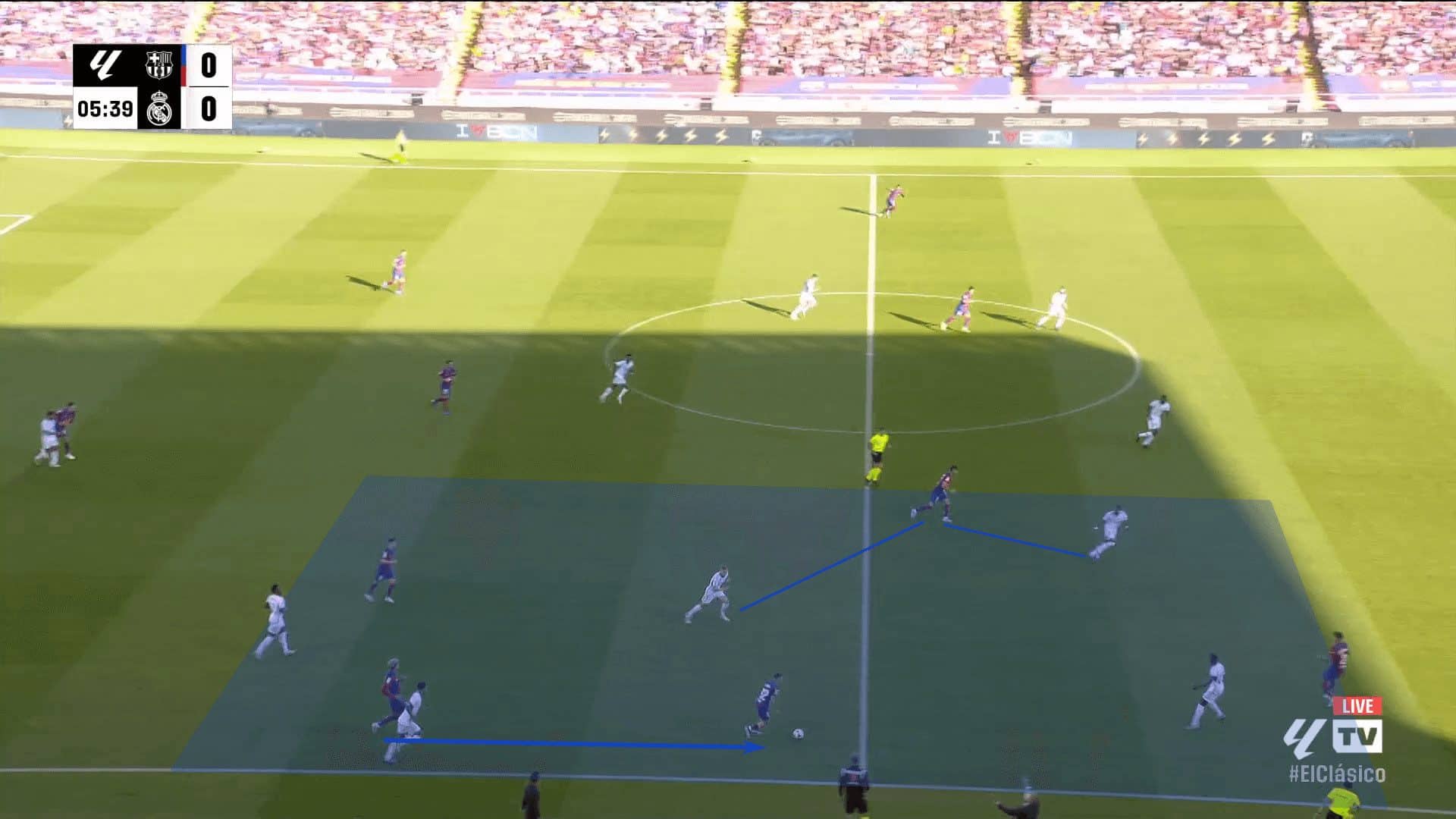
As Barcelona switched the point of attack, they created easy entries into the final third. The players who were involved in the initial overload consistently pushed up the pitch and found their positions to attack the box. That switch of play and unopposed progression up the pitch allowed those initial players in the overload to attack Zone 14.
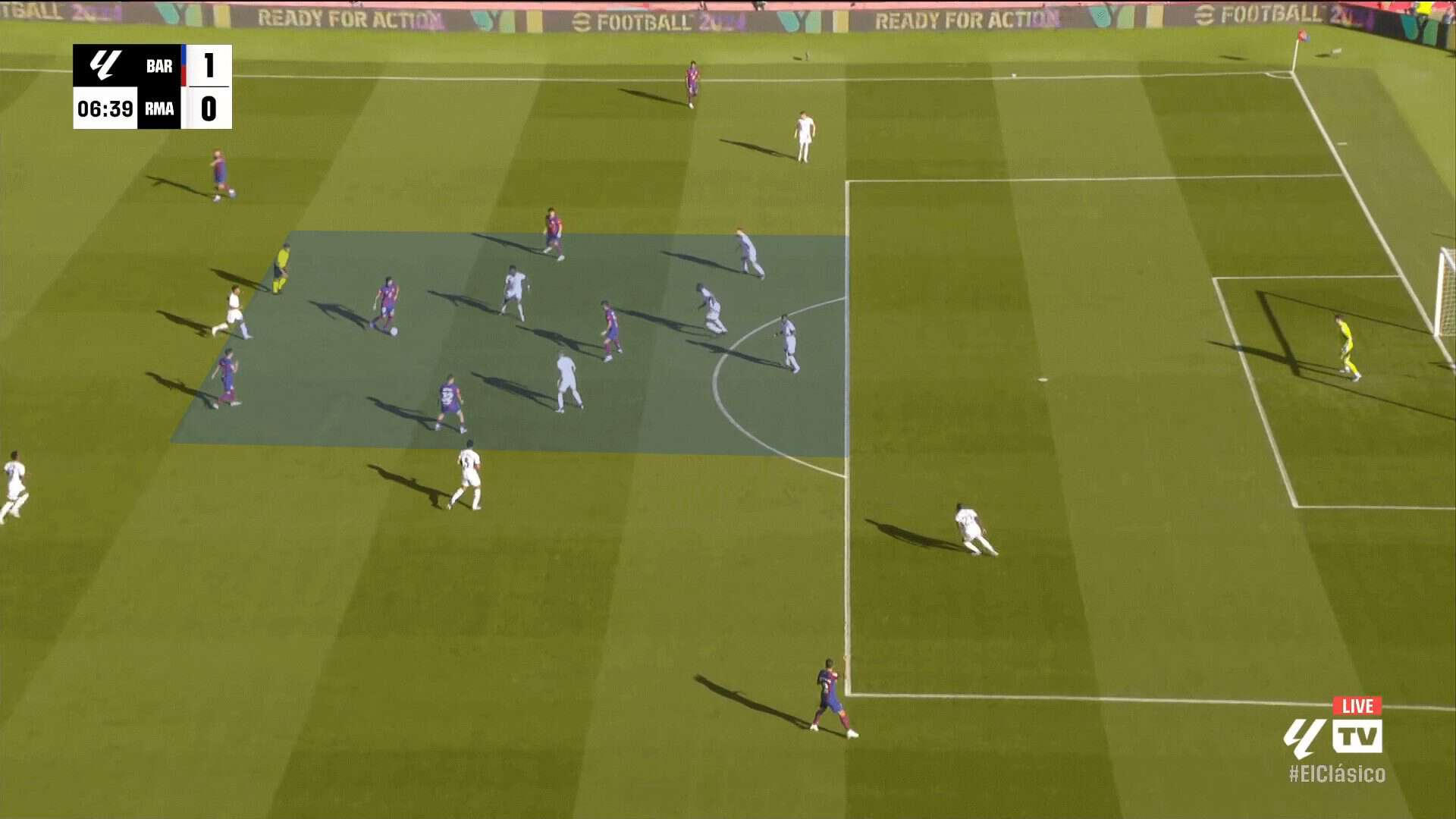
Barcelona did well to get players into that critical zone and use quick combination play to get behind the back line and produce shots. In fact, that’s where the Barcelona goal came from. Indeed, it was a fortunate deflection, but those central numbers were well-positioned to take advantage of any miscues from the Madrid backline and midfield.
Another interesting point from that previous image is how well Barcelona used high and wide players to disconnect Real Madrid’s backline. There’s very little coverage in the centre of the pitch and a lot of ground for Rüdiger and Alaba to cover.
Plus, we see here that Mendy was caught 5 m behind his centre-backs. The wide players created space for the central attackers to run into the box, creating further problems for the Madrid centre-backs.
It was a solid first-half performance from La Blaugrana, one that would certainly build up hope for a strong second half and three massive points at home.
Real Madrid’s early issues in the high press
One of the issues Real Madrid had in the first half, undoubtedly contributing to Barcelona’s success, was the way they engaged in the high press. From the very first minute, there was a clear player along the back line they were targeting. They wanted to funnel play towards Christensen, forcing him to lead the attack while applying pressure on him.
The tactics did have some success. On one of their middle recoveries, Real Madrid were able to take away his wide options and force him to play inside. His pass into João Félix was actually a decent pass, but it’s through a tight window, causing the centre-back to put some extra force on the pass, leading to a poor touch and turnover.
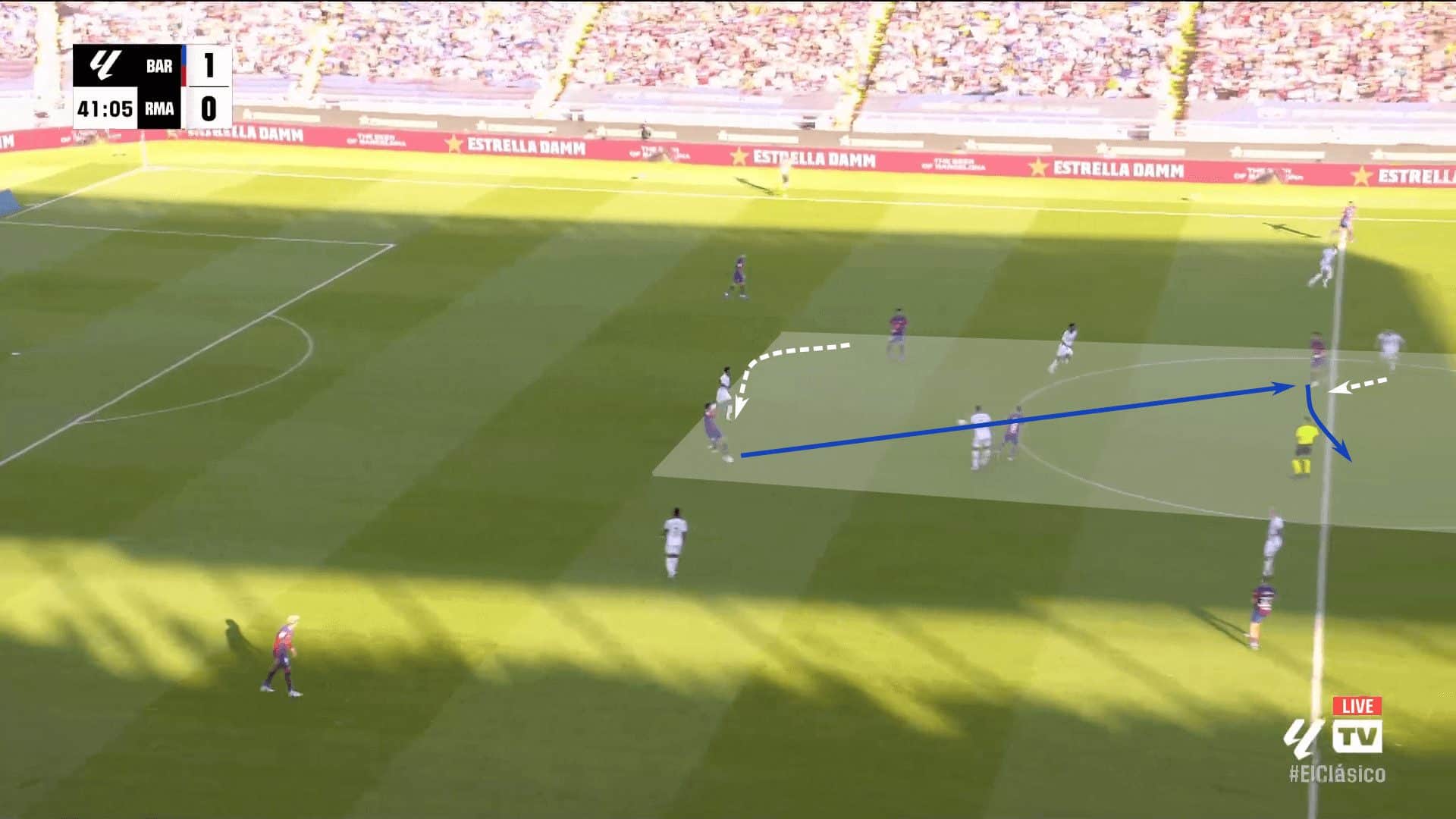
To target Christensen, Real Madrid set up with a 3-5-2 high press, man-marking the Barcelona midfield and using Valverde to offset Balde. Vinícius Júnior was responsible for Araújo, leaving Rodrygo to funnel the press away from Martínez and into the path of Christensen.
He started at the edge of the box, in line with Martínez. As ter Stegen played to Christensen, Rodrygo’s curved run was designed to eliminate passing lanes into the German goalkeeper and the former Athletic Club centre-back. The Real Madrid midfielders remain close to their marks, especially Gavi, to prevent triangulated passes in a 4-6-5 pattern to break the press.
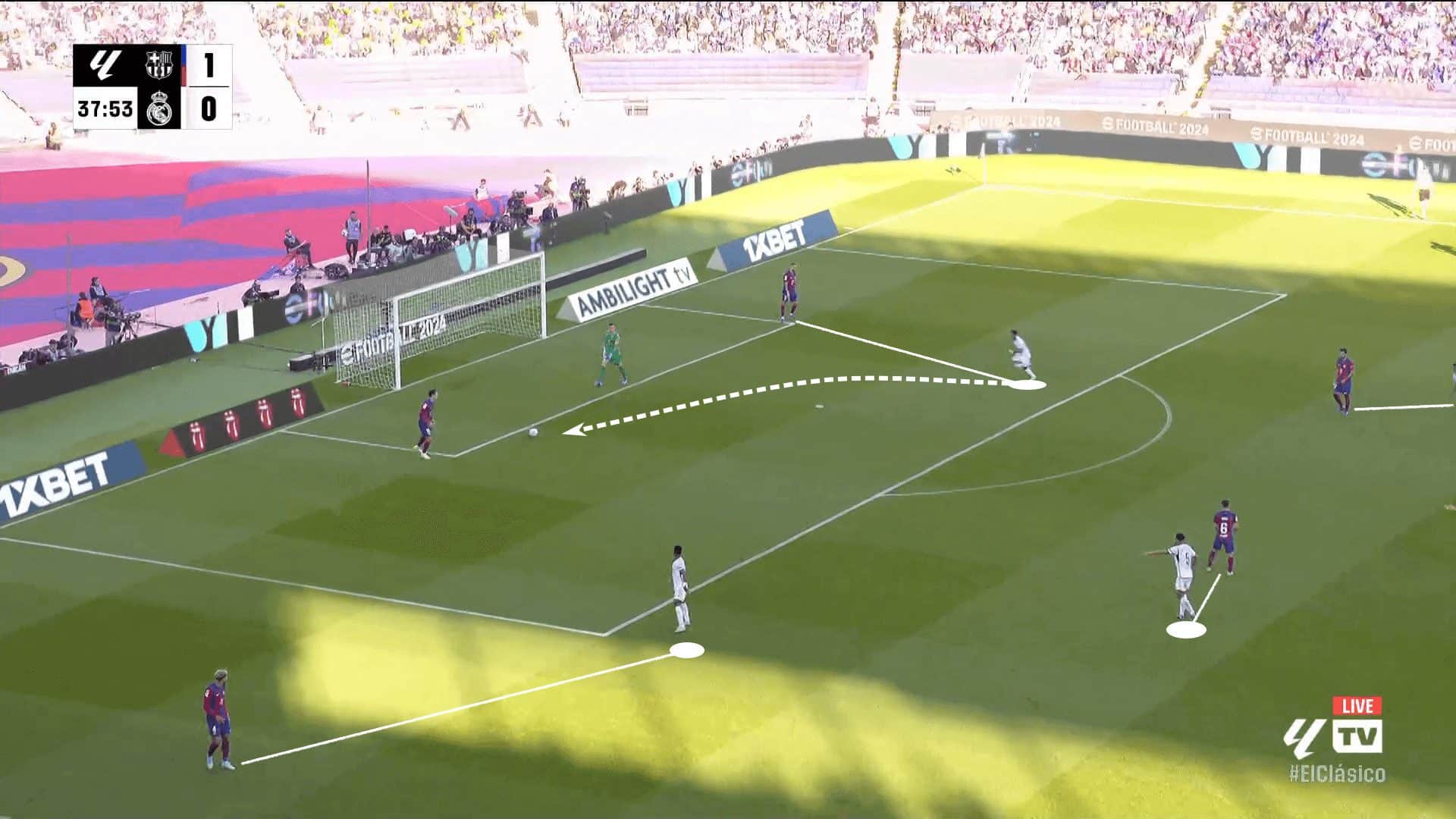
The issue is that Christensen showed excellent composure to play around pressure. In the first half especially, he could link up with Araújo and his midfield, beating the press.
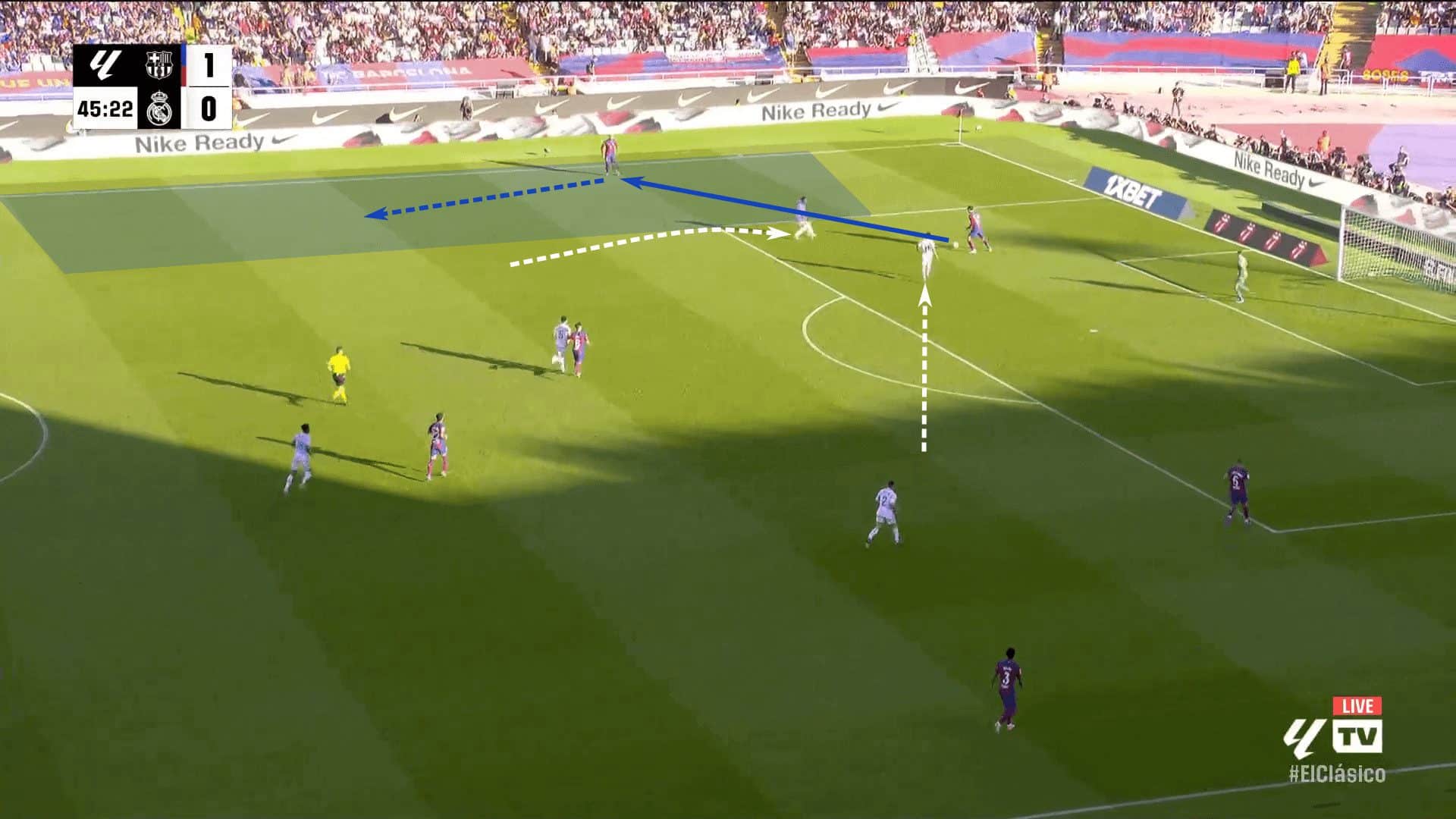
The result was that his press-breaking passes typically played Barcelona into large pockets of space. With the first line, and even a midfielder or two, beaten, Barcelona could take large amounts of space quickly, forcing difficult recoveries for the Real Madrid press.
For the game, Real Madrid were the better of the two sides in terms of high regains, recording 11 to Barcelona’s five and 17 counterpressing recoveries in the attacking half of the pitch to Barcelona’s seven. Looking at the high regains map, Real Madrid’s recoveries were well-balanced in the attacking half. There isn’t one particular area that stands out, giving a sense that the particular tactics to funnel play into Christensen and earn recoveries from his mistakes didn’t quite come off.
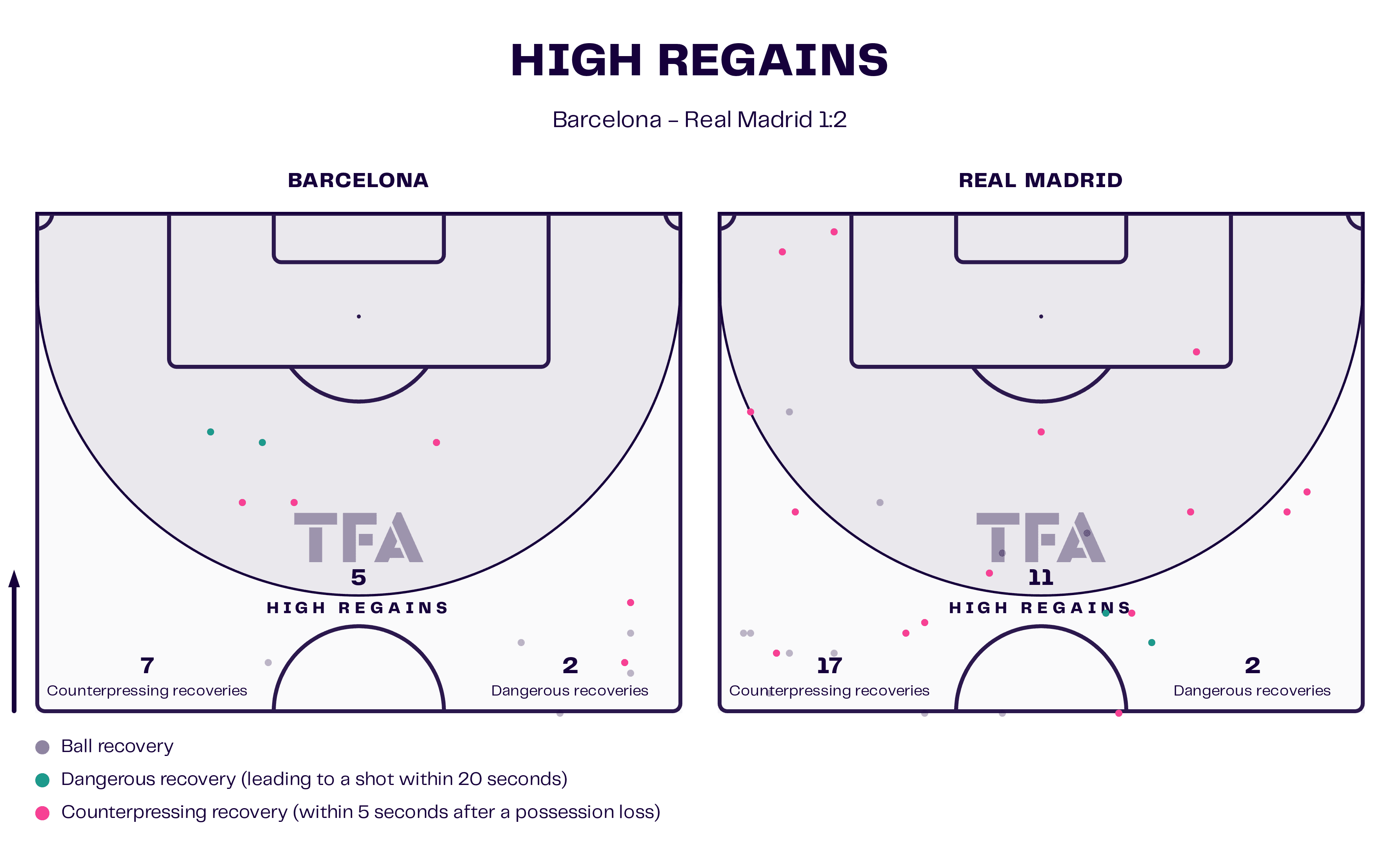
Criticising a press that clearly had success may seem a bit strange, but this also plays a role in showing how the tide of the game turned in Madrid’s favour.
Substitutes changed the game
Barcelona enjoyed a slight edge in the first half and started the second well. With several players returning from injury in time for El Clásico, Barcelona must have felt confident of three points. The starting XI gave them a lead, and they had the pieces on the bench to see out the result.
However, right around the 50th minute, momentum gradually swung in the visitor’s favour. Perhaps it’s no coincidence that Eduardo Camavinga stepped onto the pitch in the 51st minute as a like-for-like replacement for Mendy. The versatile midfielder took his now familiar role as the auxiliary left-back to help Real Madrid progress through the left wing and support Vinícius Júnior in his gruelling battle against Araújo.
With Vinícius Júnior pinning Araújo deep on Barcelona’s right, essentially resigning him to the role of a stay-at-home right back, there was space to attack on Real Madrid’s left side. Mendy struggled to add value to the attack, leading to the substitution. As usual, Camavinga injected energy into a struggling attack.
Luka Modrić stepped on for Toni Kroos in the 63rd minute, accompanied by a swap of Joselu for Rodrygo, pushing Valverde to right forward. That move allowed Real Madrid’s front three to occupy all four members of Barcelona’s backline, creating more space for others to attack, especially Camavinga and Bellingham.
In the build-up to the game-winner, it was a calm and collected trivela from Modrić that sprung Camavinga into space on the left. With no one in front of him, he drove forward, taking the uncontested space, something he added to Real Madrid’s approach for the entirety of his time on the pitch.
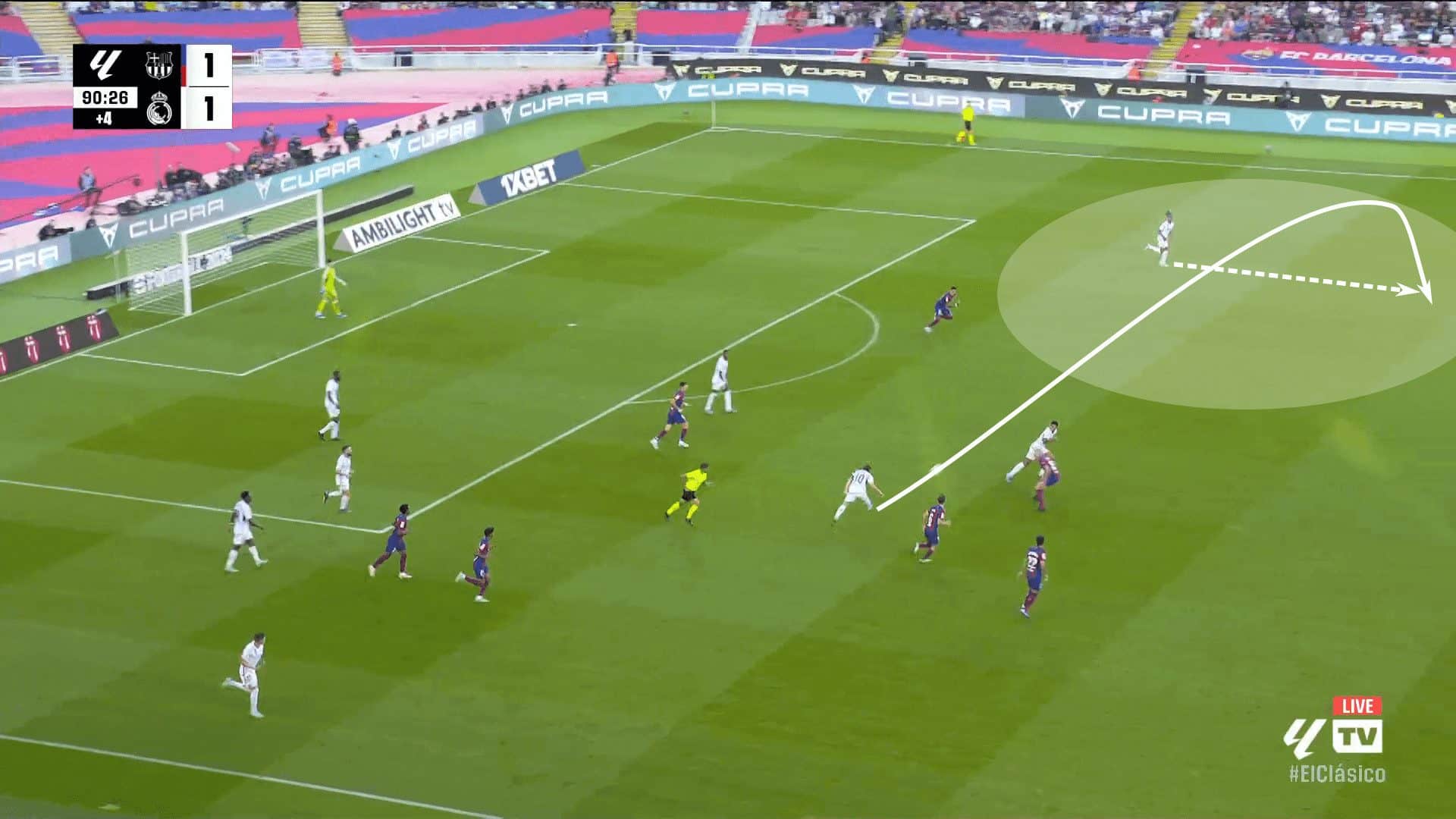
This analysis would be remiss to ignore the individual quality Camavinga brought to the final third. His 1v1 dribbling ability added another dimension, one that was sorely lacking with Mendy on the pitch. Just before the equaliser, Camavinga beat his man in the wings and drove into the box before being wrestled to the ground by Araújo.
The referee signalled for play to continue, and it was Real Madrid who would capitalise as a fortunate deflection from Modrić fell into the path of Bellingham, who silenced the crowd and earned a “what are we supposed to do about it” smirk from Xavi.
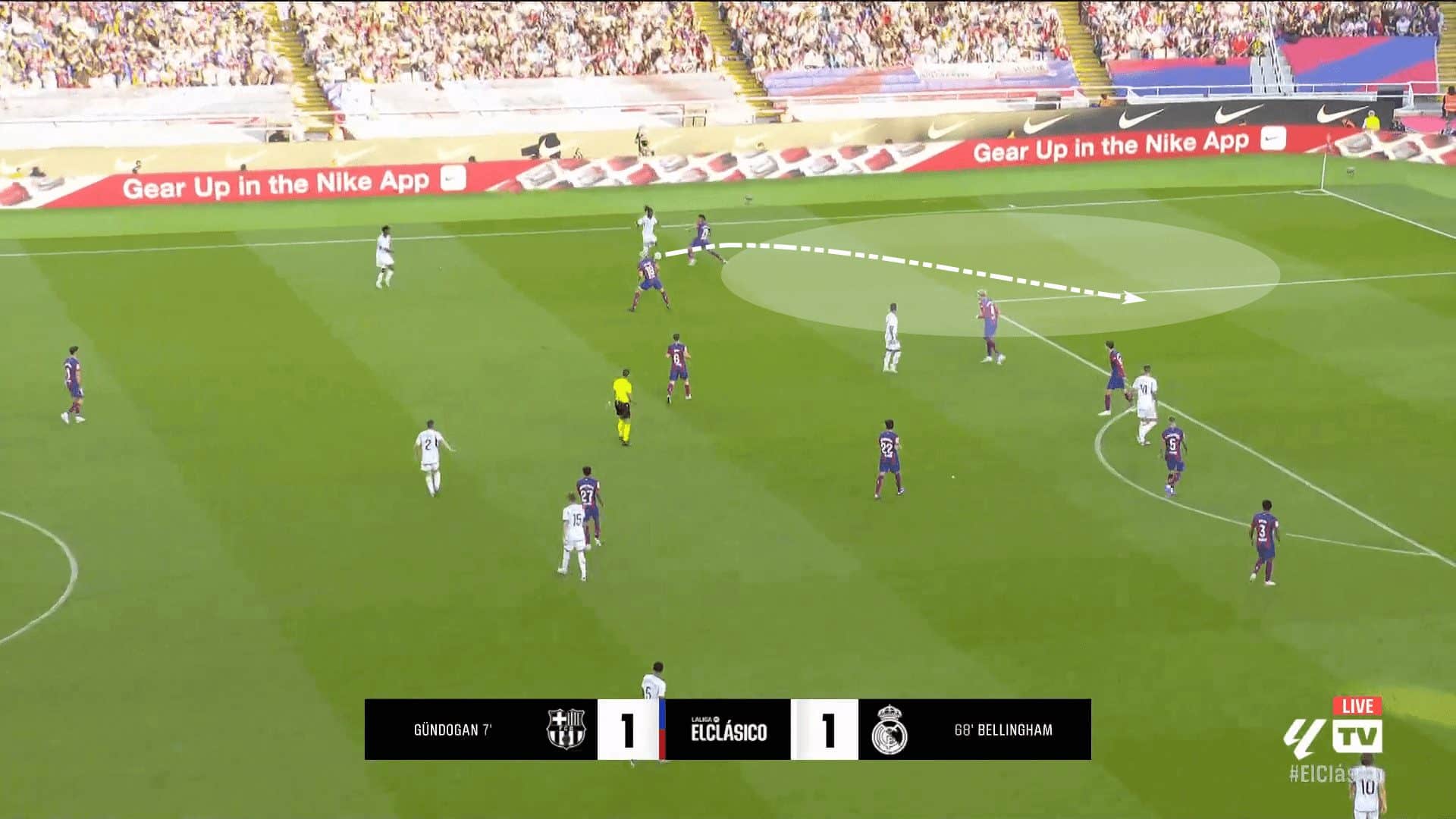
Comparing each side’s ball progression count, Barcelona had more success progressing on their right, which coincides with Real Madrid’s left. It was that side of the pitch that received most of the action and was pivotal to the outcome of the game. The red dots on Real Madrid’s progression map show the level of success Araújo enjoyed against Vinícius Júnior. Adding the attacking threats of Camavinga at left-back was a pivotal moment in the match.
Ancelotti’s analysis of the first half was spot on, identifying the need for more support for the Brazilian on the left. Replacing Mendy with Camavinga was a game-changer.
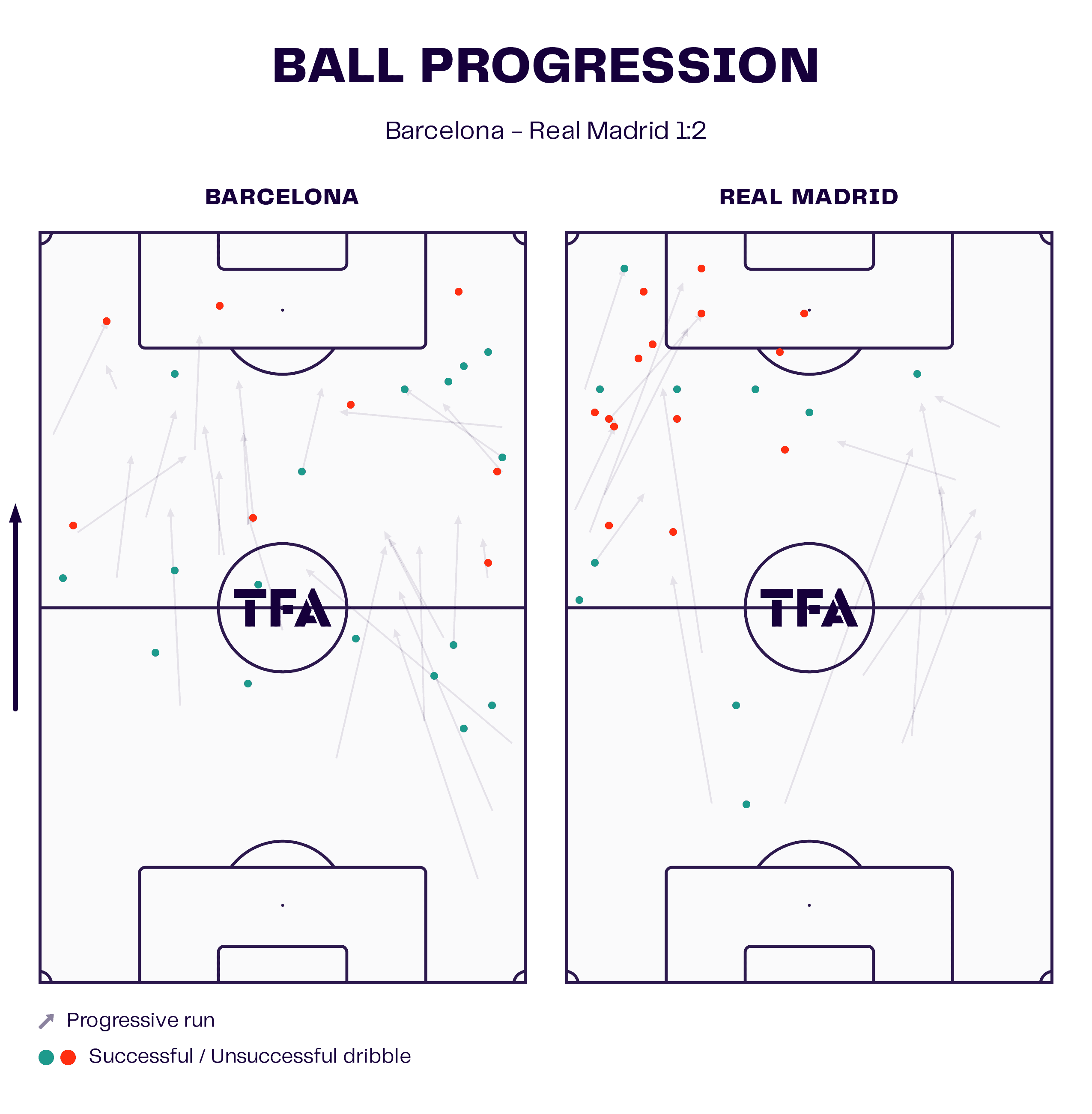
Barcelona were not without their subs. Robert Lewandowski replaced Torres at the #9 in the 61st minute but struggled to impose himself on the match. The lack of directness with Torres out of the game seemed to stifle Barcelona’s production in the attacking half.
In the 72nd minute, Oriol Romeu and Raphinha replaced Fermín López and João Félix. This came minutes after the Bellingham equaliser. Indeed, a different look along the forward line but a more defensive look in midfield.
As Barcelona struggled to regain their footing in the match, Romeu’s struggles in possession only exacerbated the problem. He was forced to play a vital role in Barcelona’s build-outs and connect their lines near midfield. Under the weight of Real Madrid’s press, Romeu had several instances that hurt Barcelona, either holding on to the ball too long or playing errant passes that led to opportunities for Los Blancos. The misplaced pass below nearly set Vinícius Júnior on to goal. Only a last-ditch tackle by Christensen kept the Brazilian from entering the box.
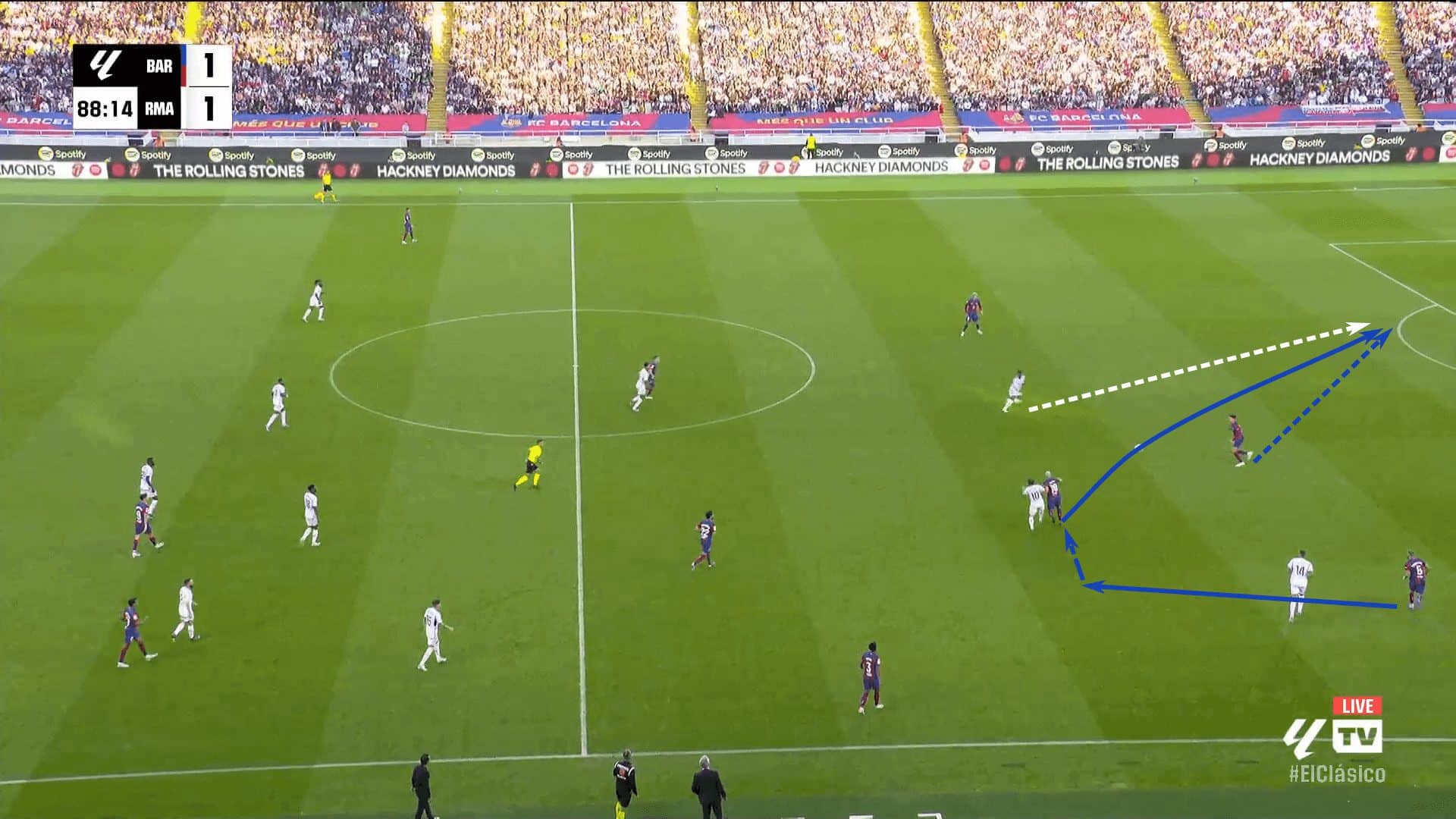
On the whole, his positioning wasn’t bad. It was typically his lagging decision-making that compromised the team. Even in the example below, where his positioning could have been slightly closer to the ball in order to swing it to the free player in the right wing, it was his slow reaction to the pace of the pass into him and his decision not to step to the ball that allowed Real Madrid to get a touch and poke it beyond the Barcelona backline.
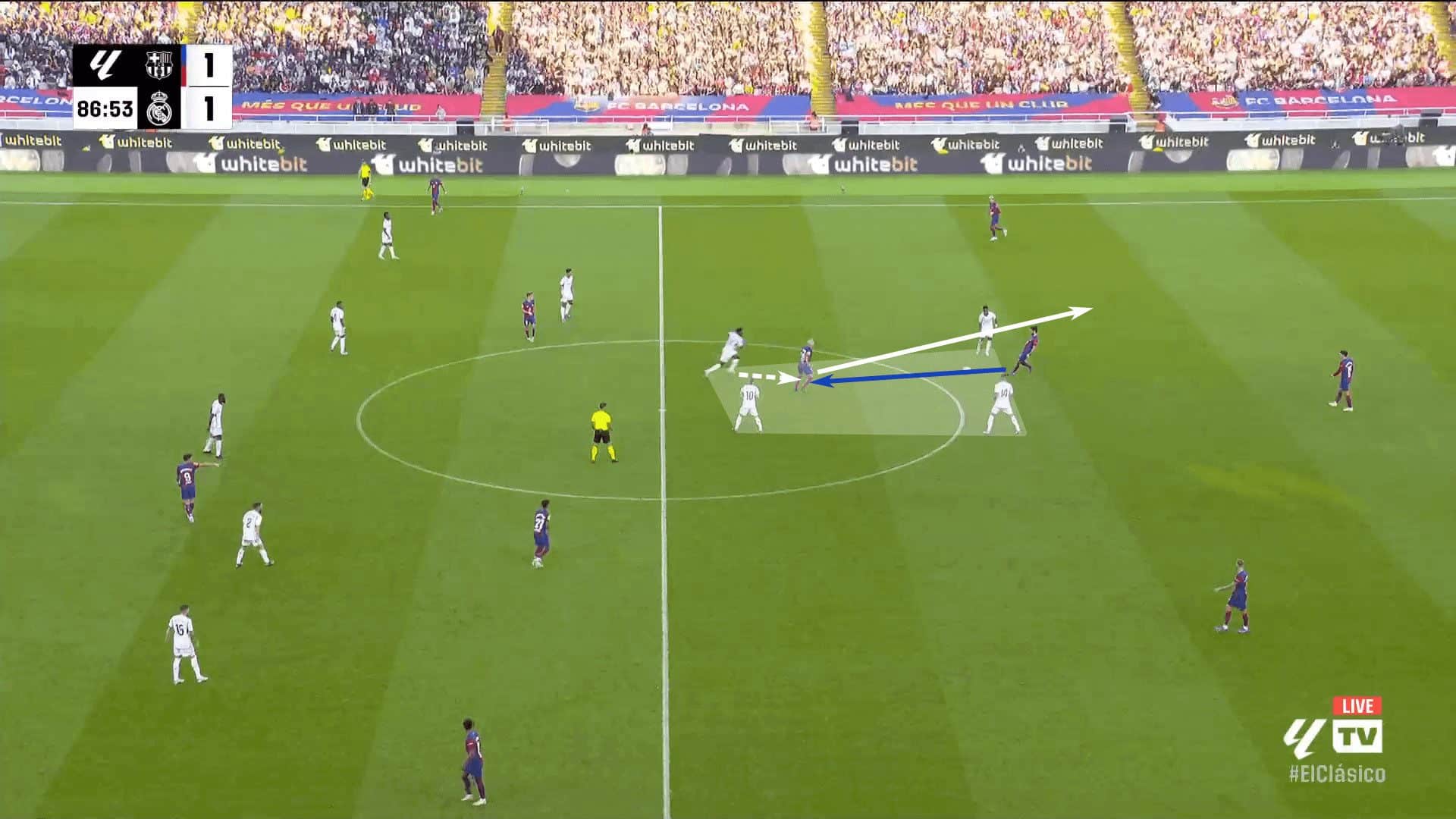
Insecurity in midfield and the lack of impact by the attackers who came on failed to wrestle control of the game from Real Madrid.
In contrast, Ancelotti’s subs changed the dynamic of the match. Camavinga’s entry was especially important, giving Real Madrid a second threat in the left wing. Once he entered the game, Madrid had a lot of success attacking through the left.
Conclusion
The stoppage-time winner and Bellingham’s brace earned the headlines, and there’s no denying that the young English superstar deserves the praise. His start at the club can only be described as scintillating.
Bellingham’s heroics may have captured the spotlight, but, as seen in this tactical analysis, Camavinga and the subs changed the game, helping Real Madrid claim momentum and keep it. Ancelotti’s high press may have struggled against Barcelona’s overloads and Christensen’s composure, but his adjustments at half-time were spot on.
Real Madrid walks away from this match with a four-point lead on their arch-nemesis and is again level on points with upstart Girona at the top of La Liga’s table.
We’re still early in the season, and it’s all to play for, but Saturday’s performance and dramatics will only boost the confidence of this Real Madrid side. Even when the result seems out of reach, they continue to find a way, with the newest Madridista proving he’s decisive.





Comments